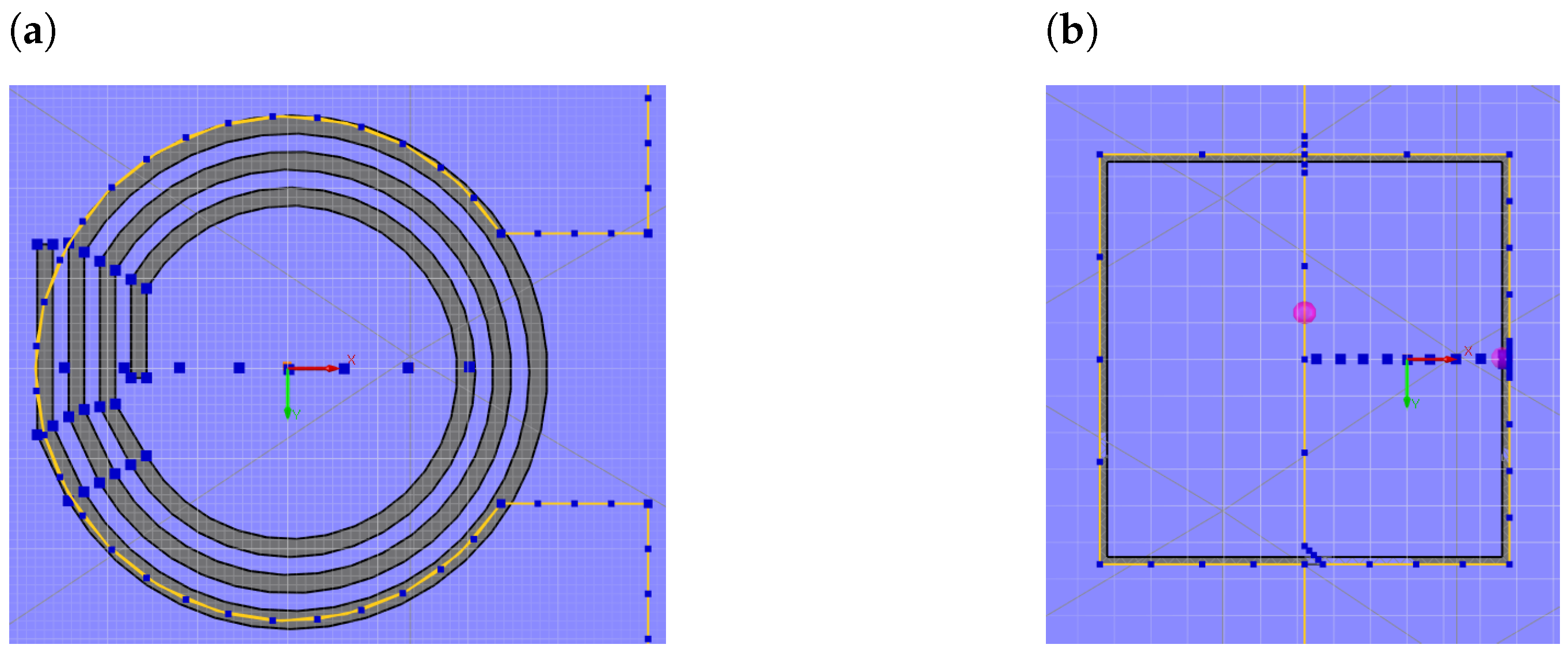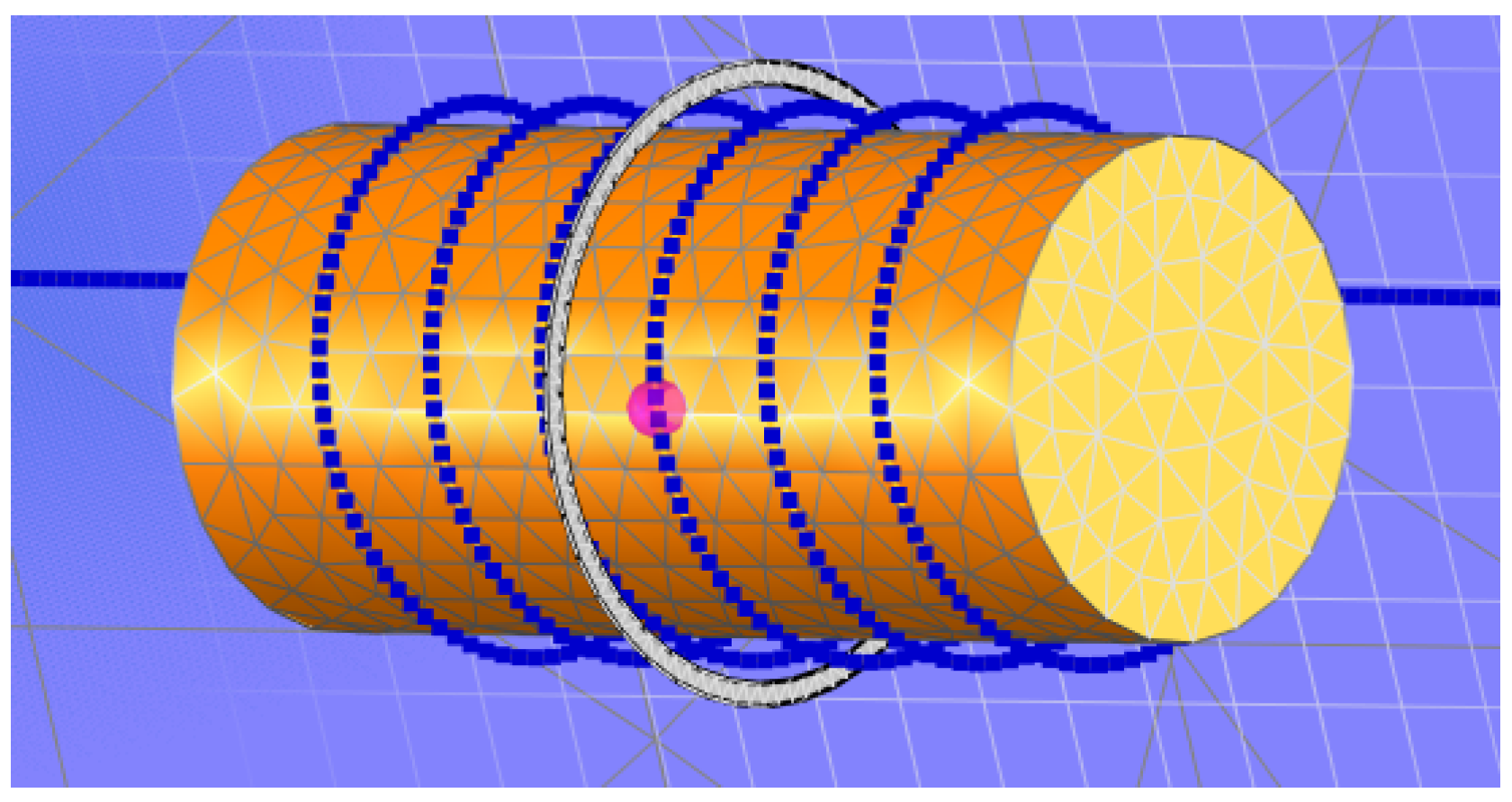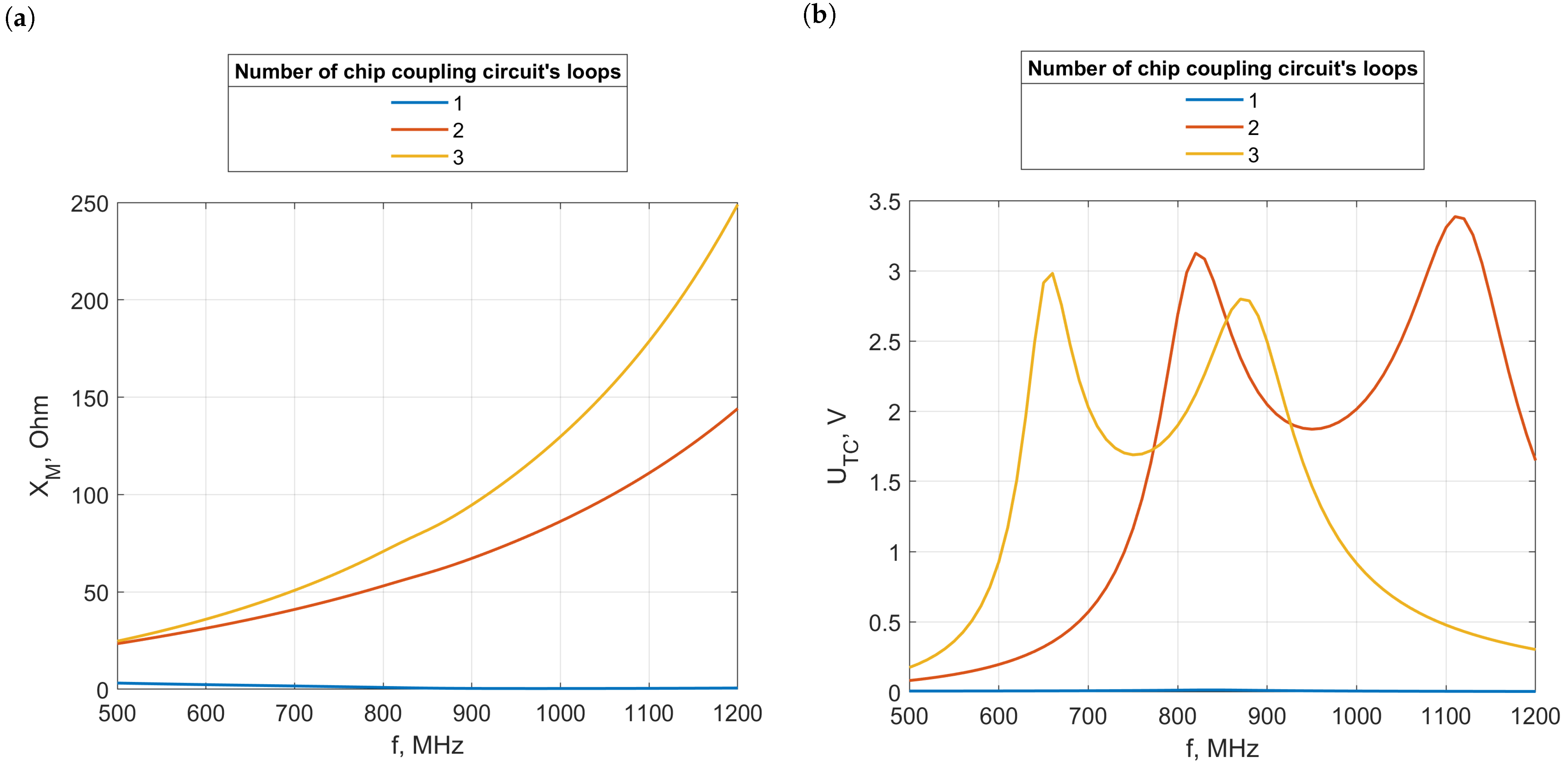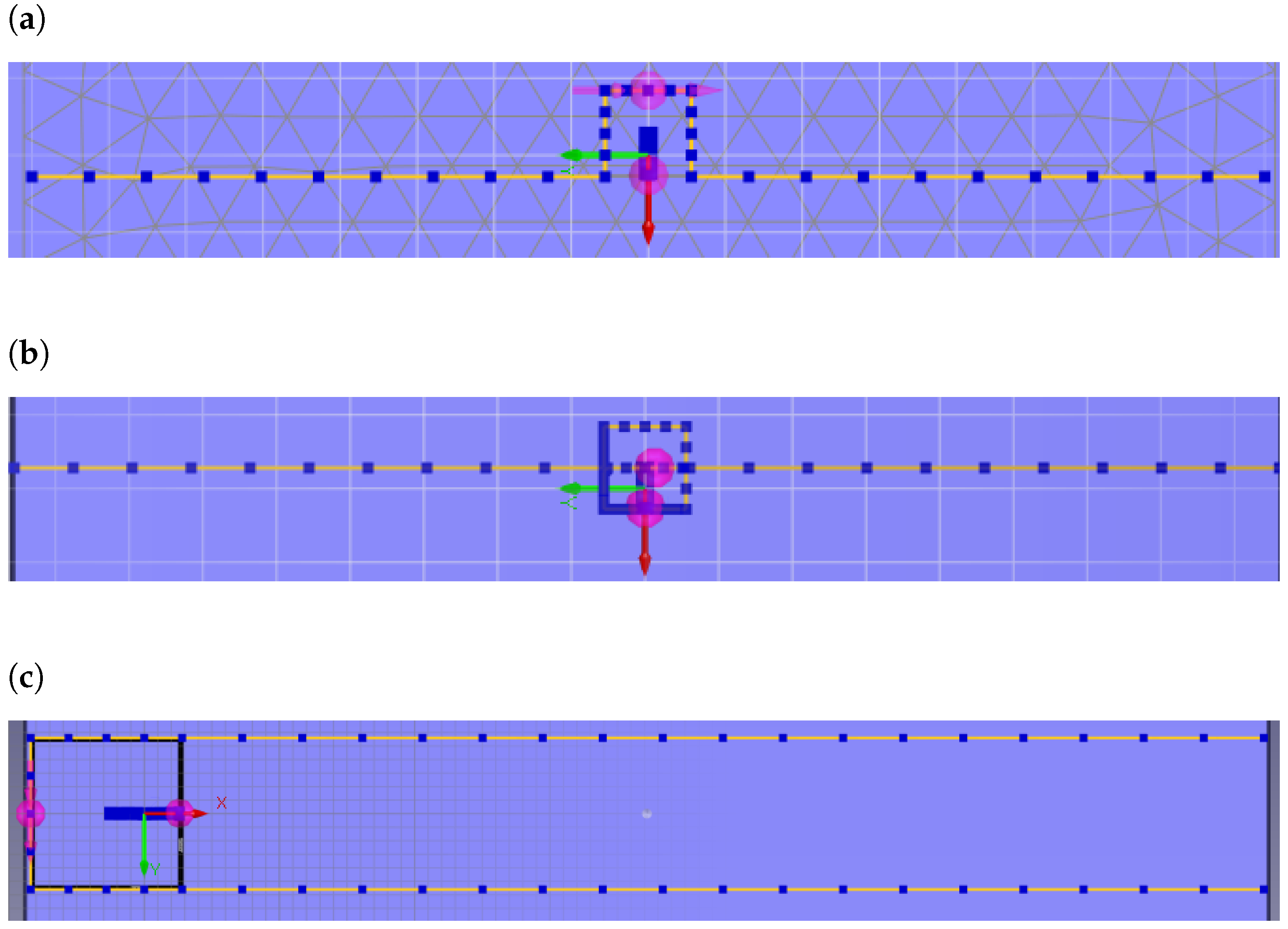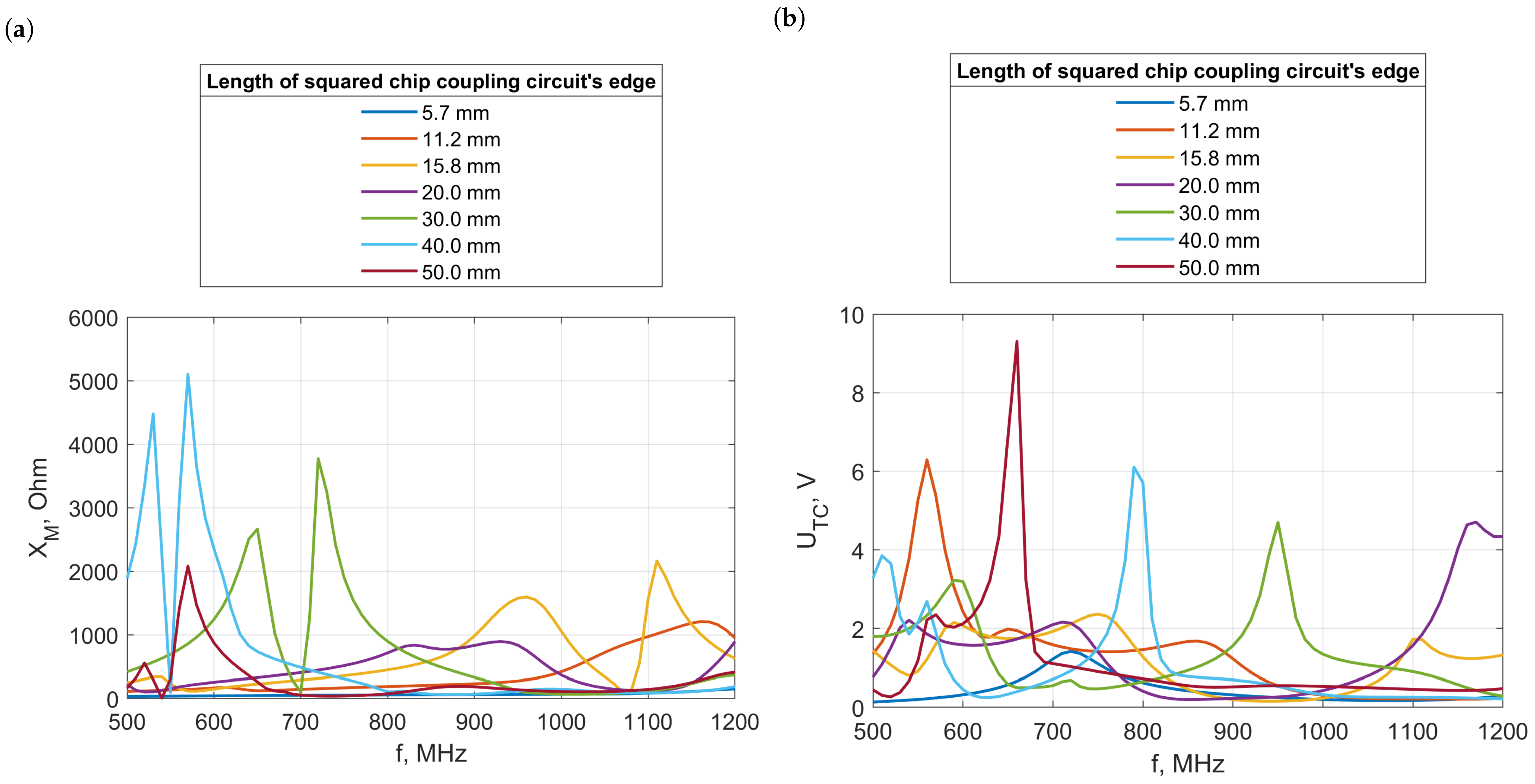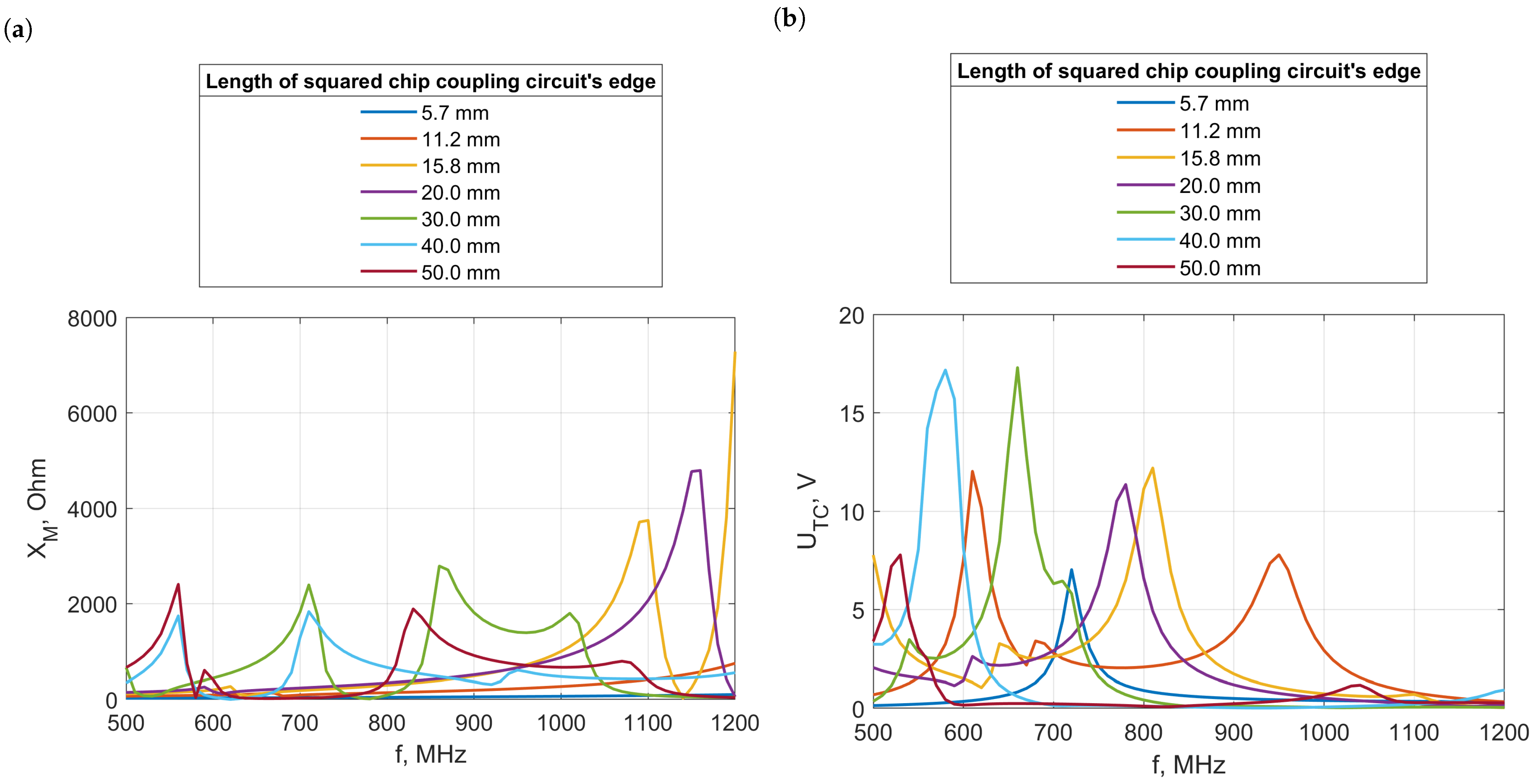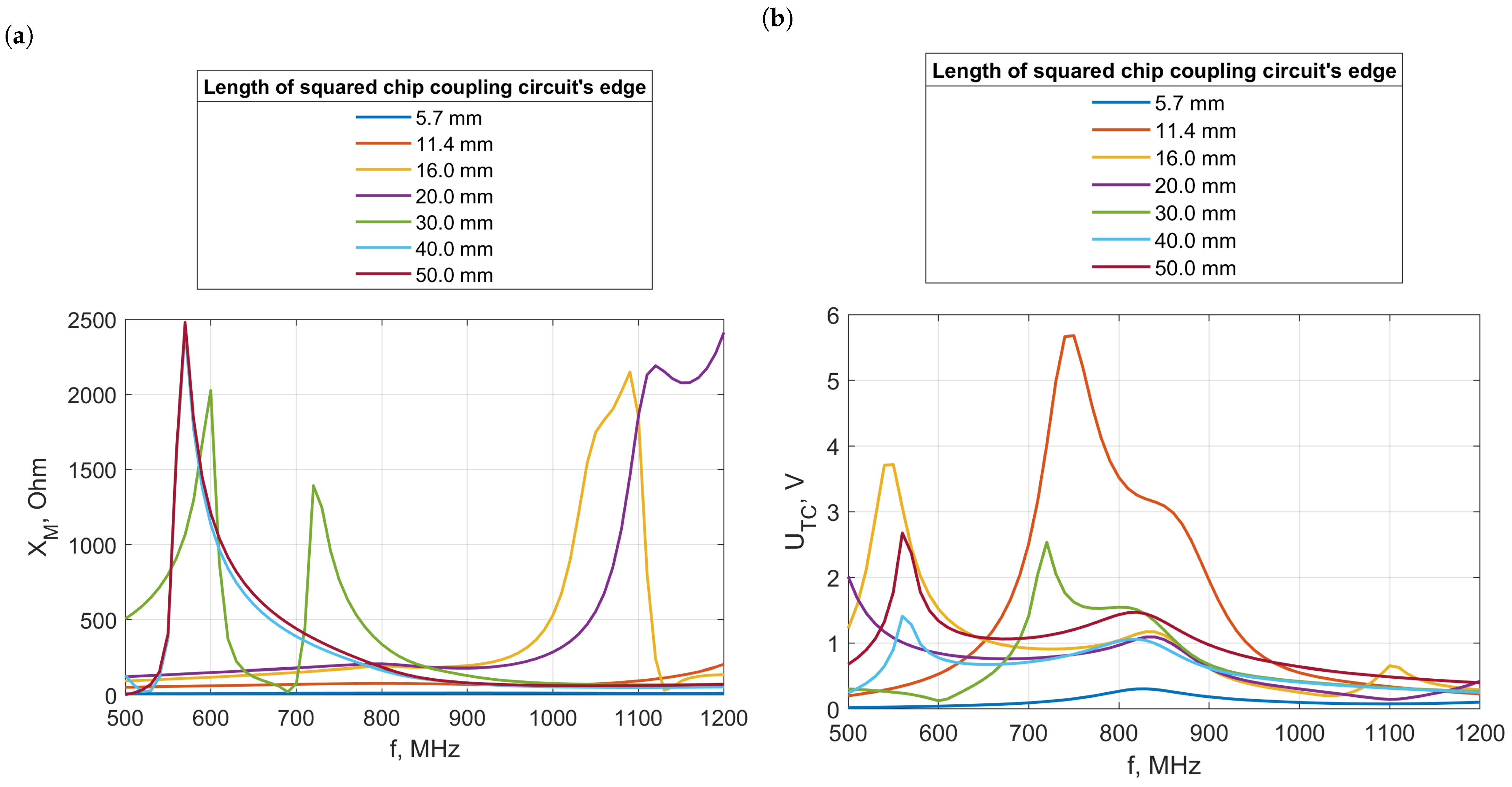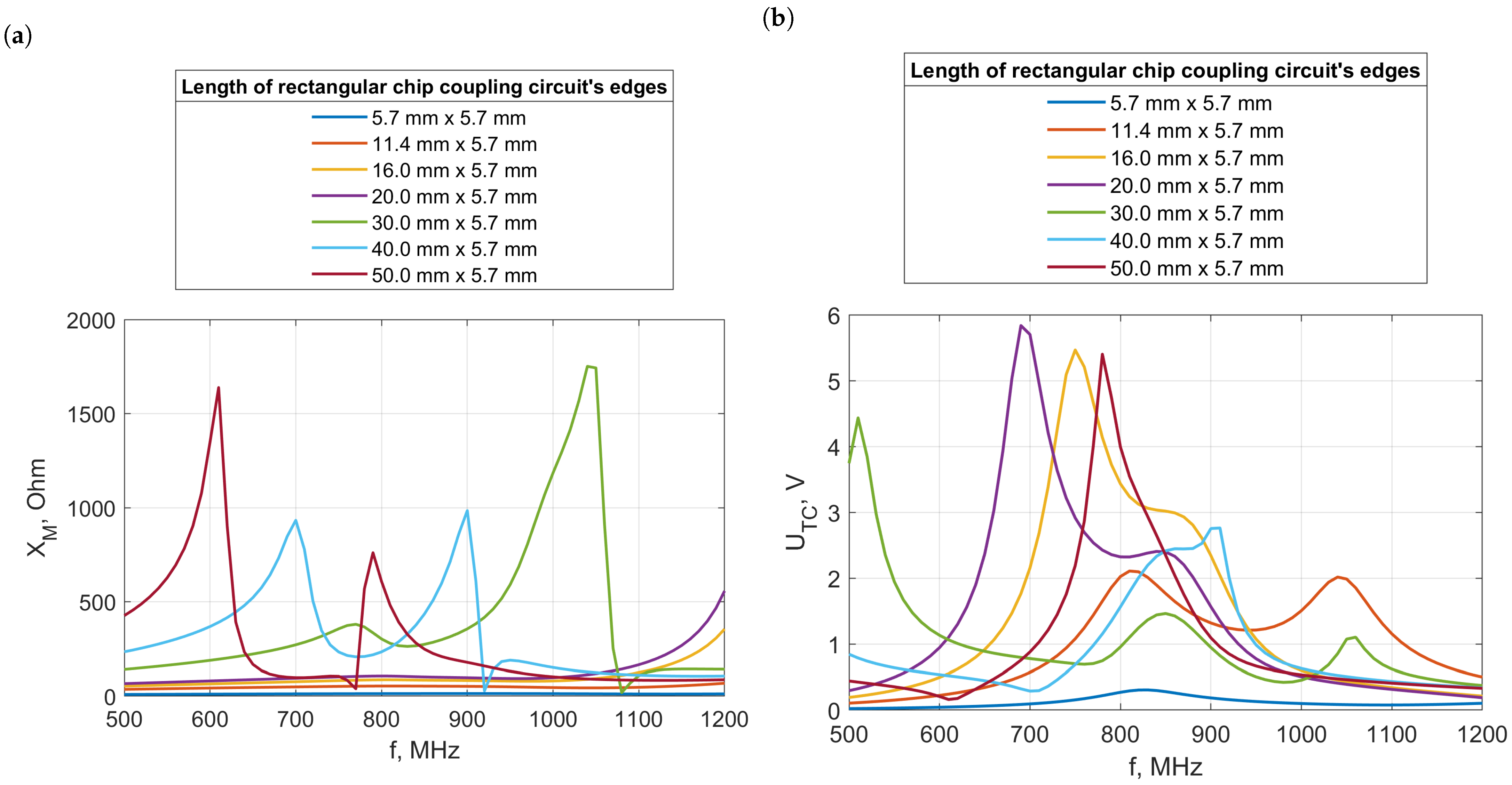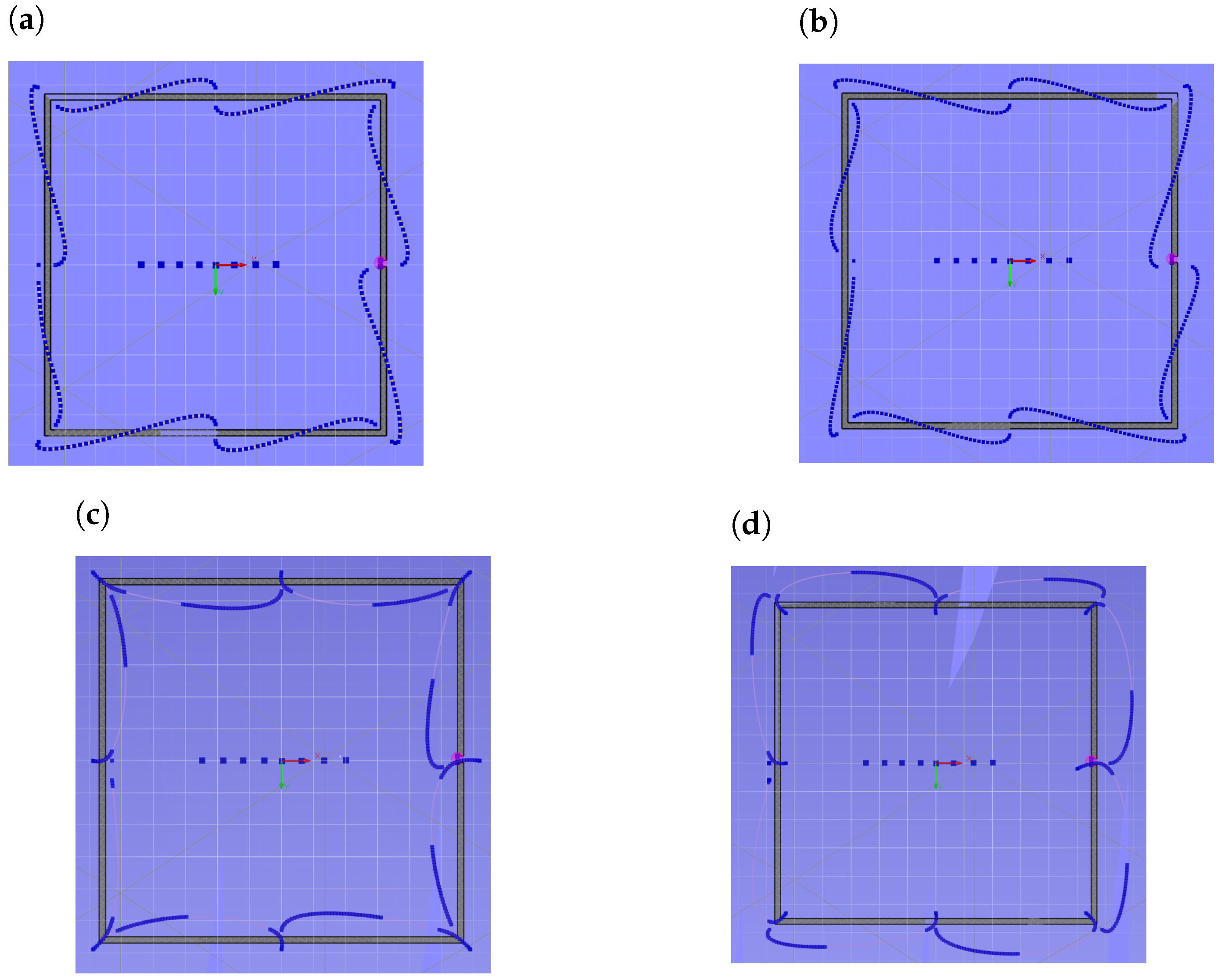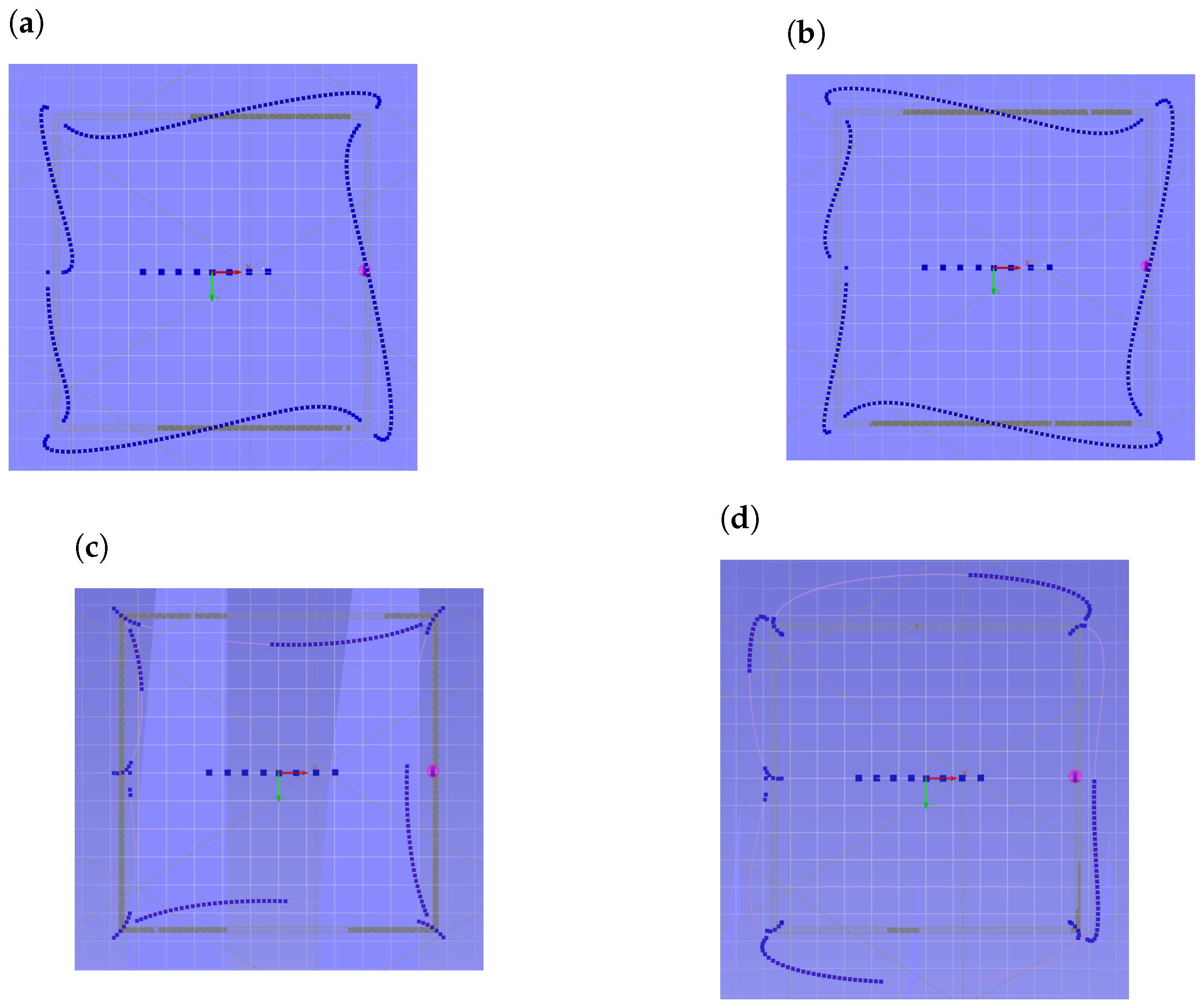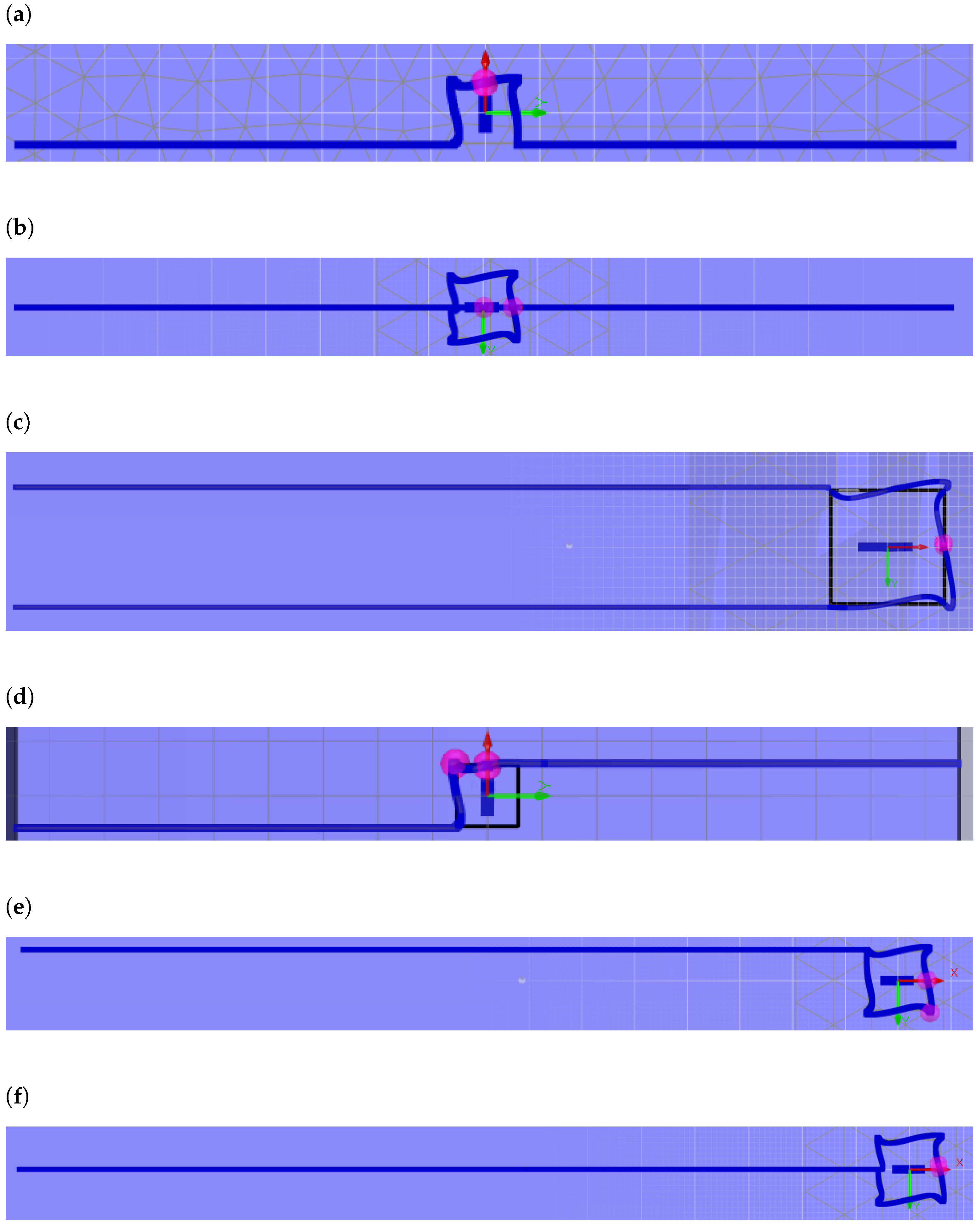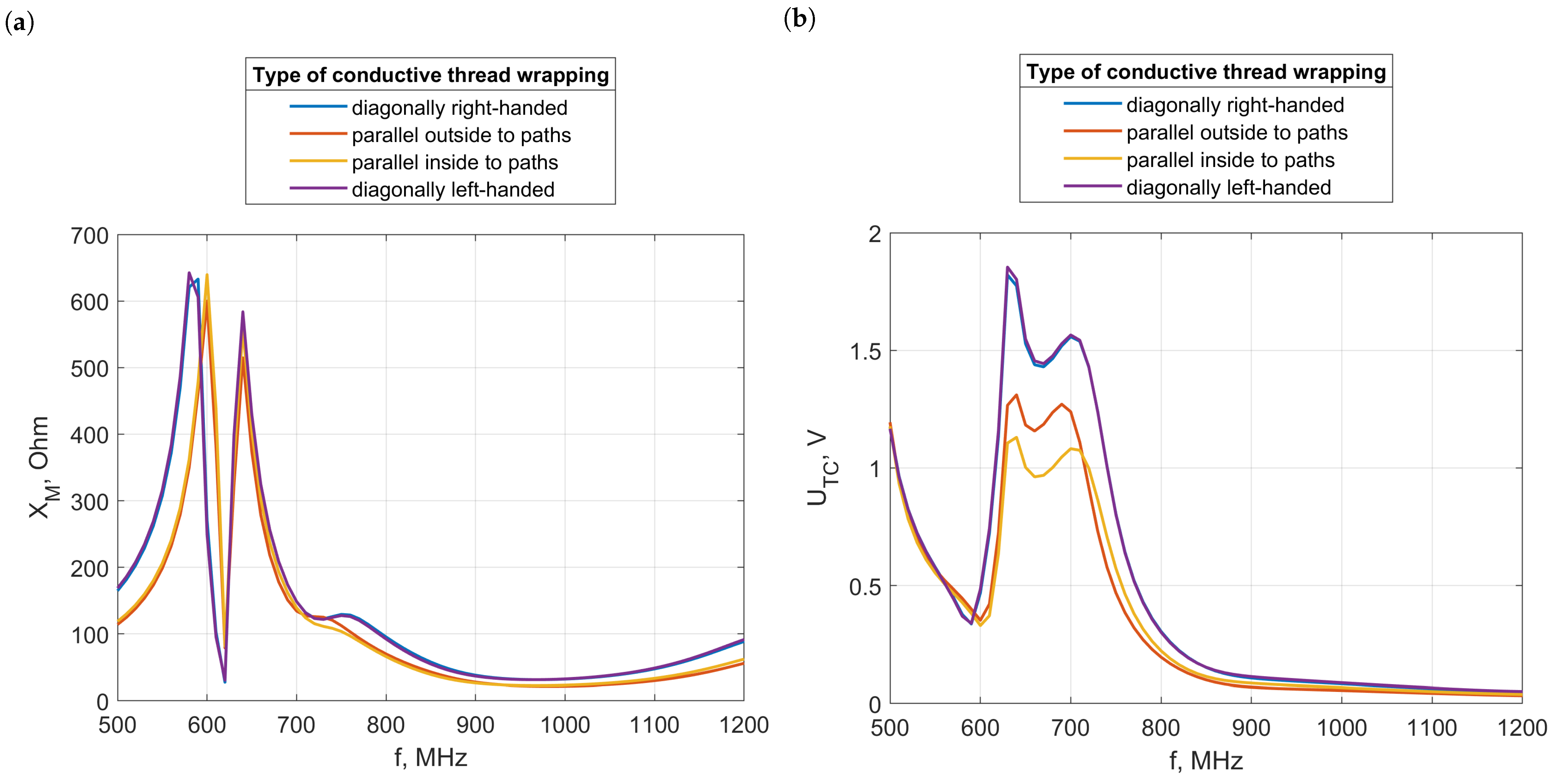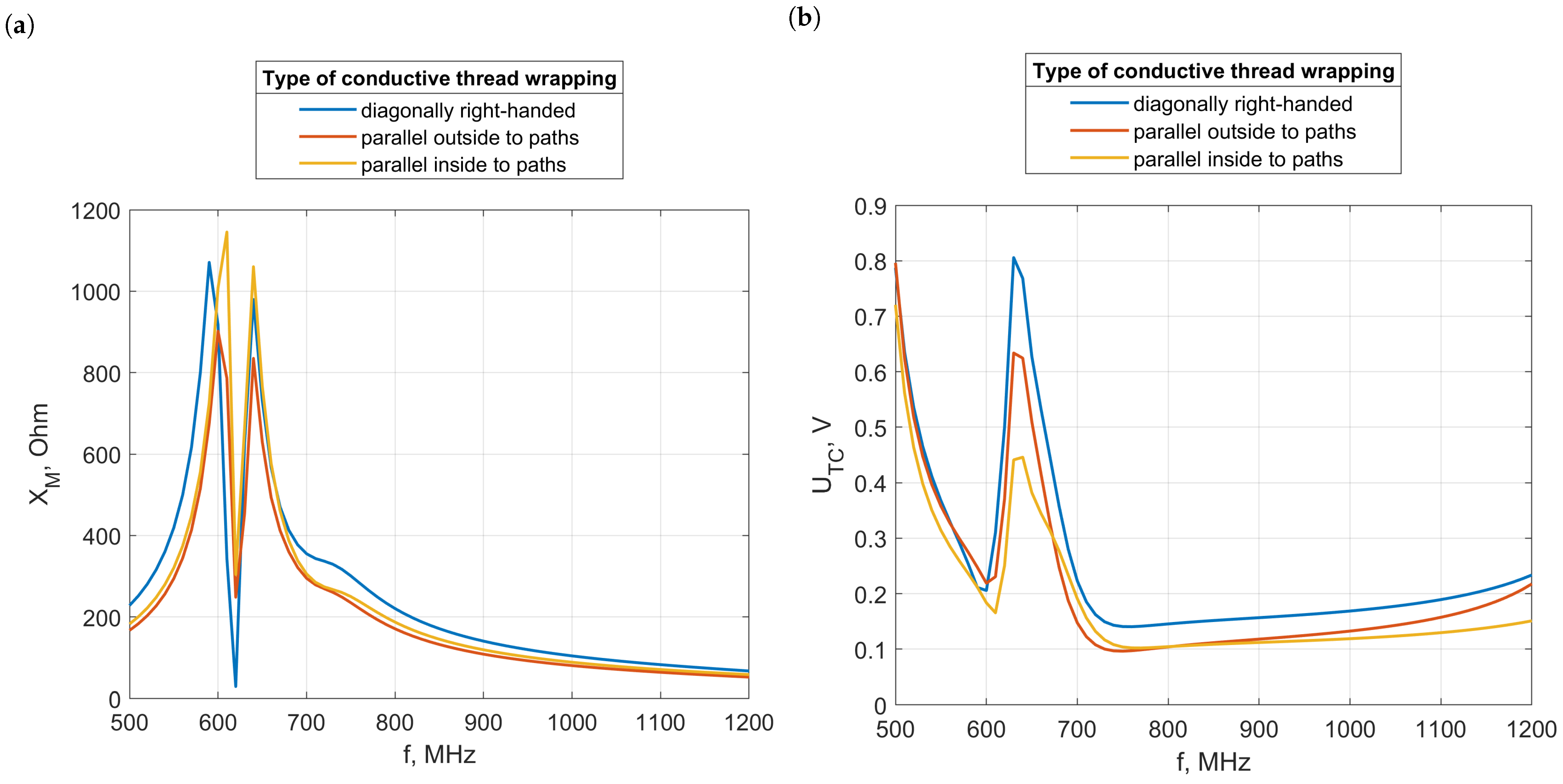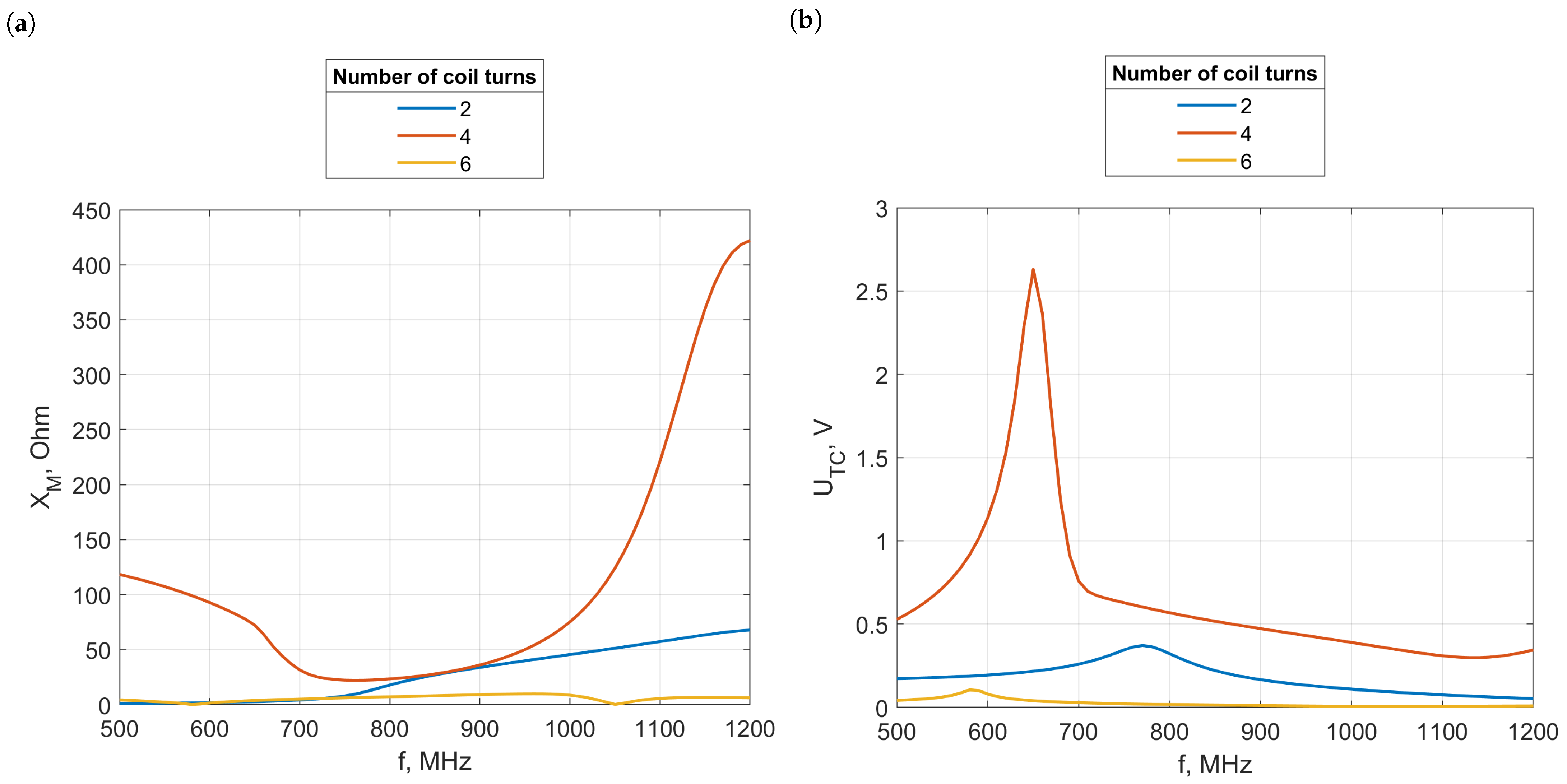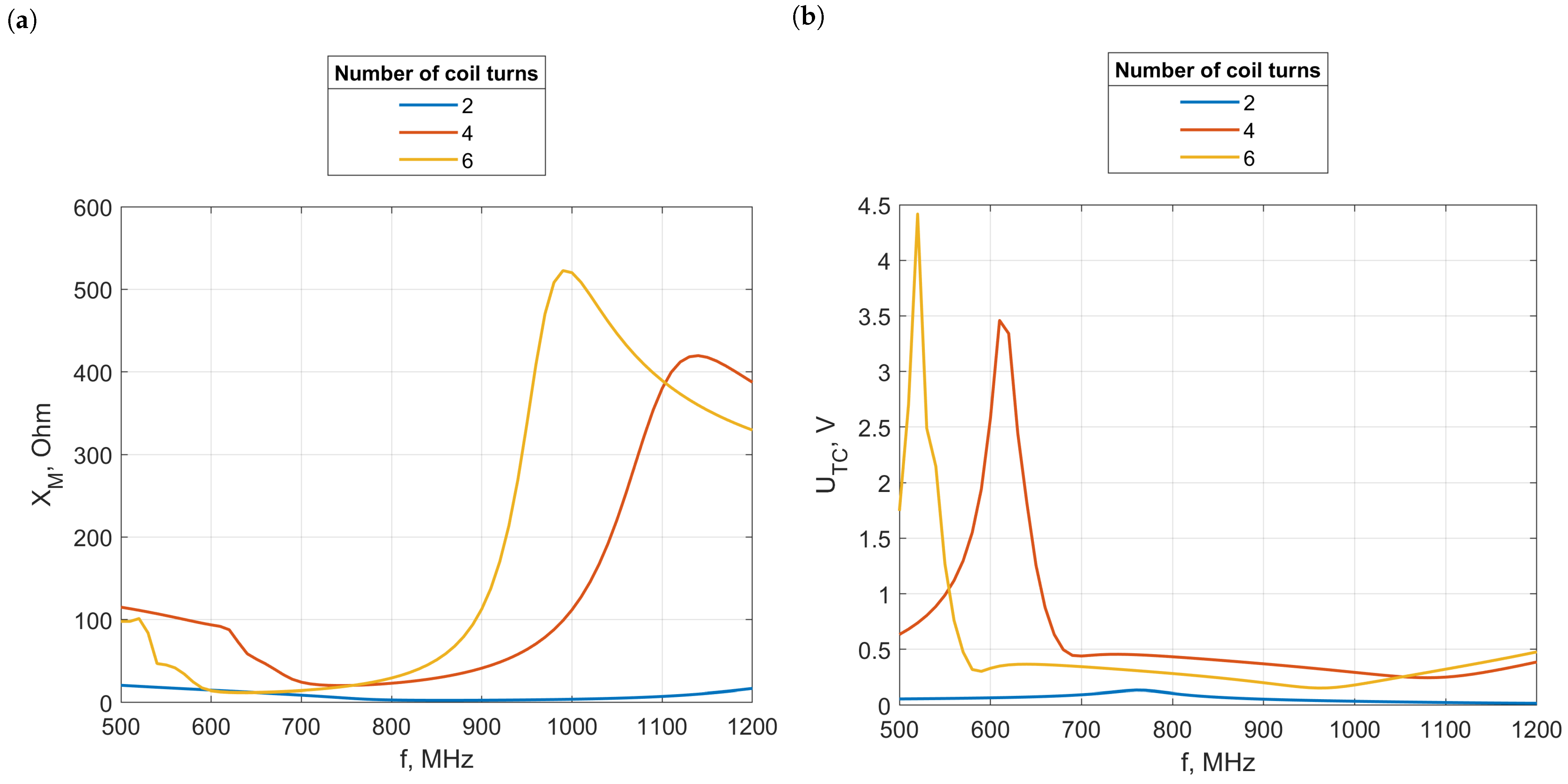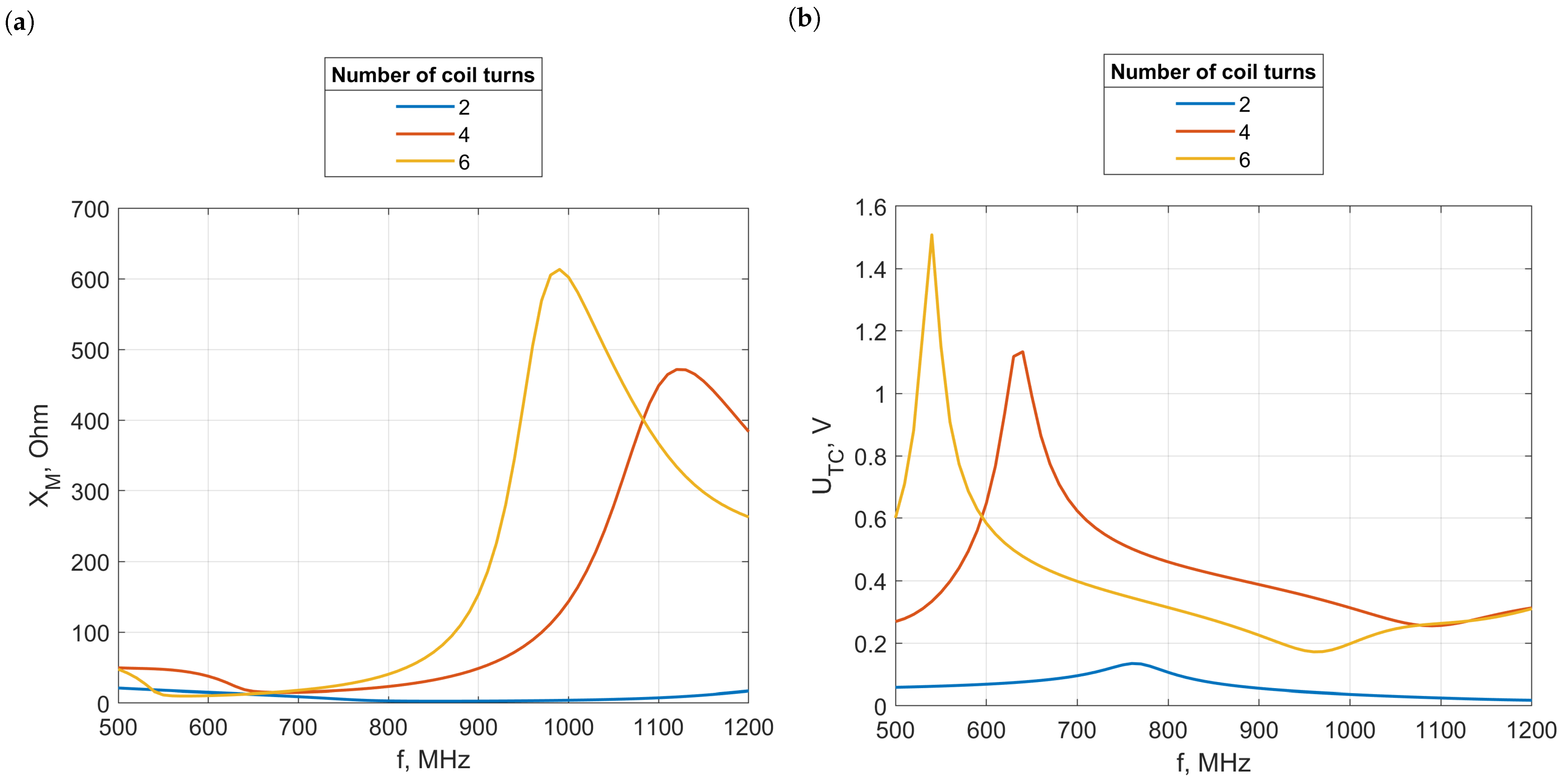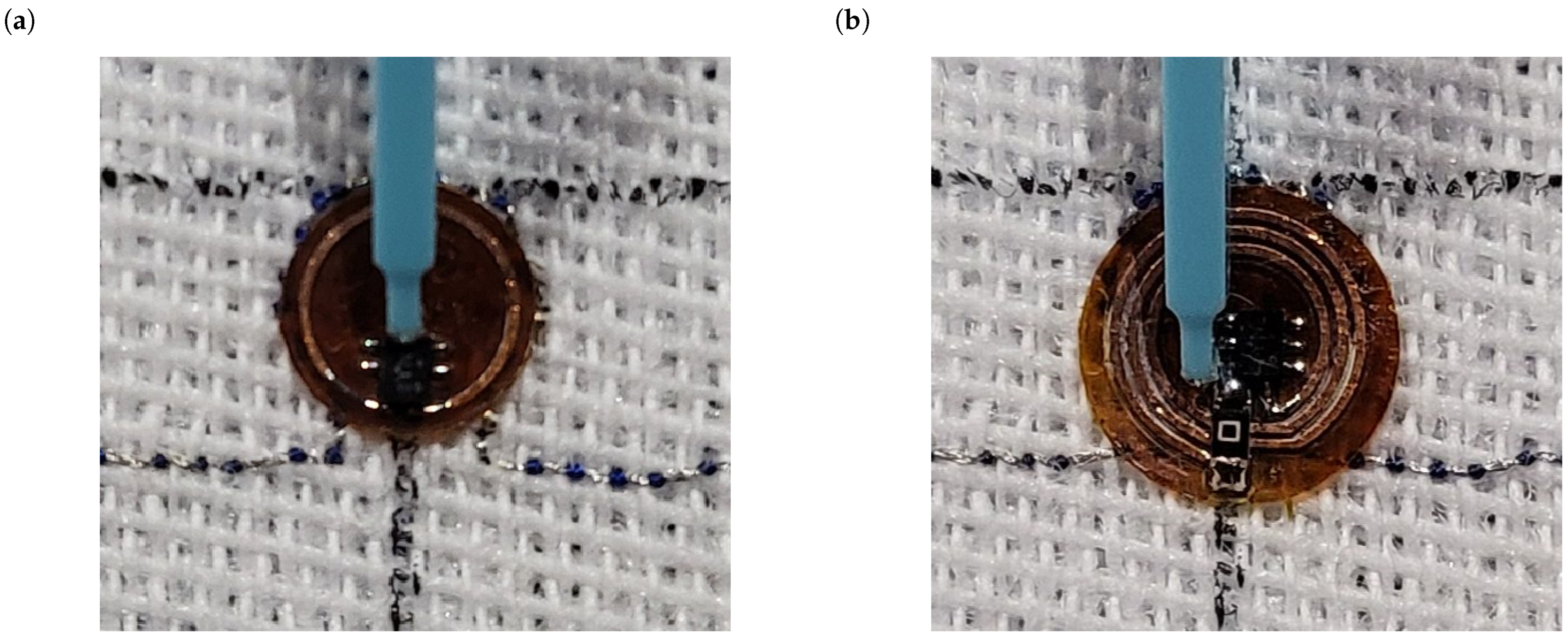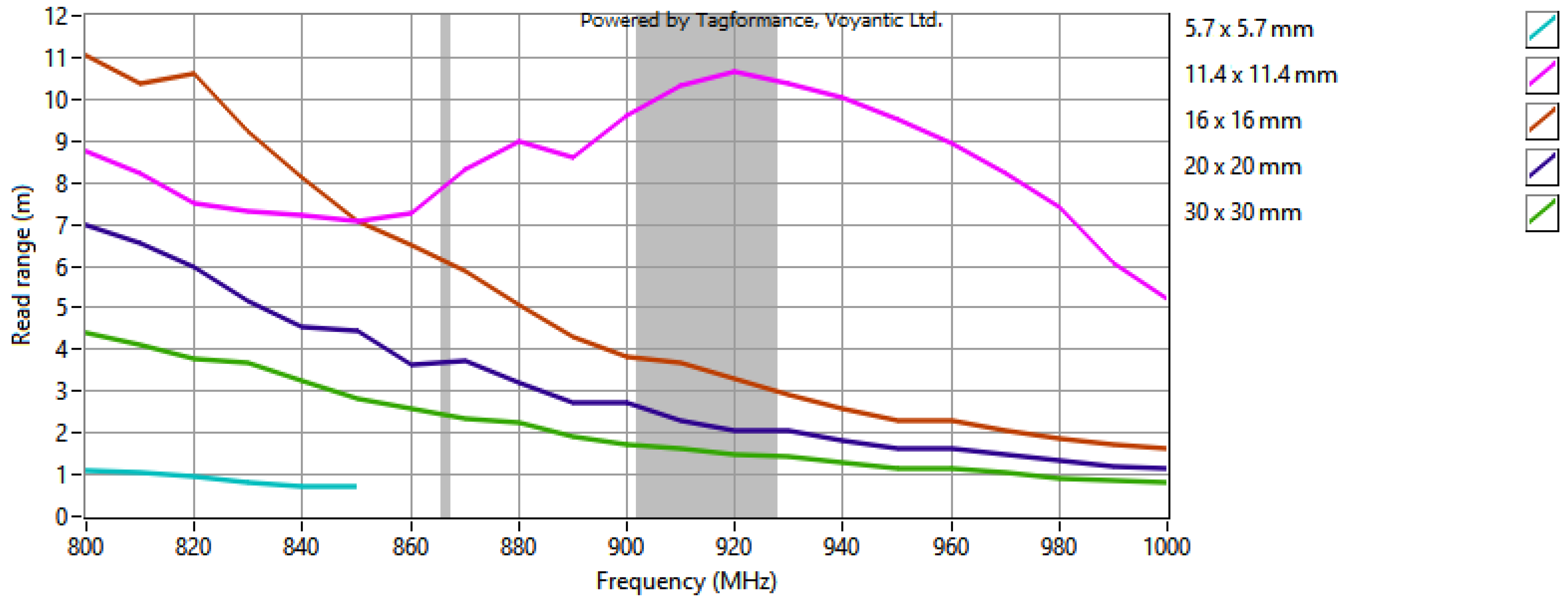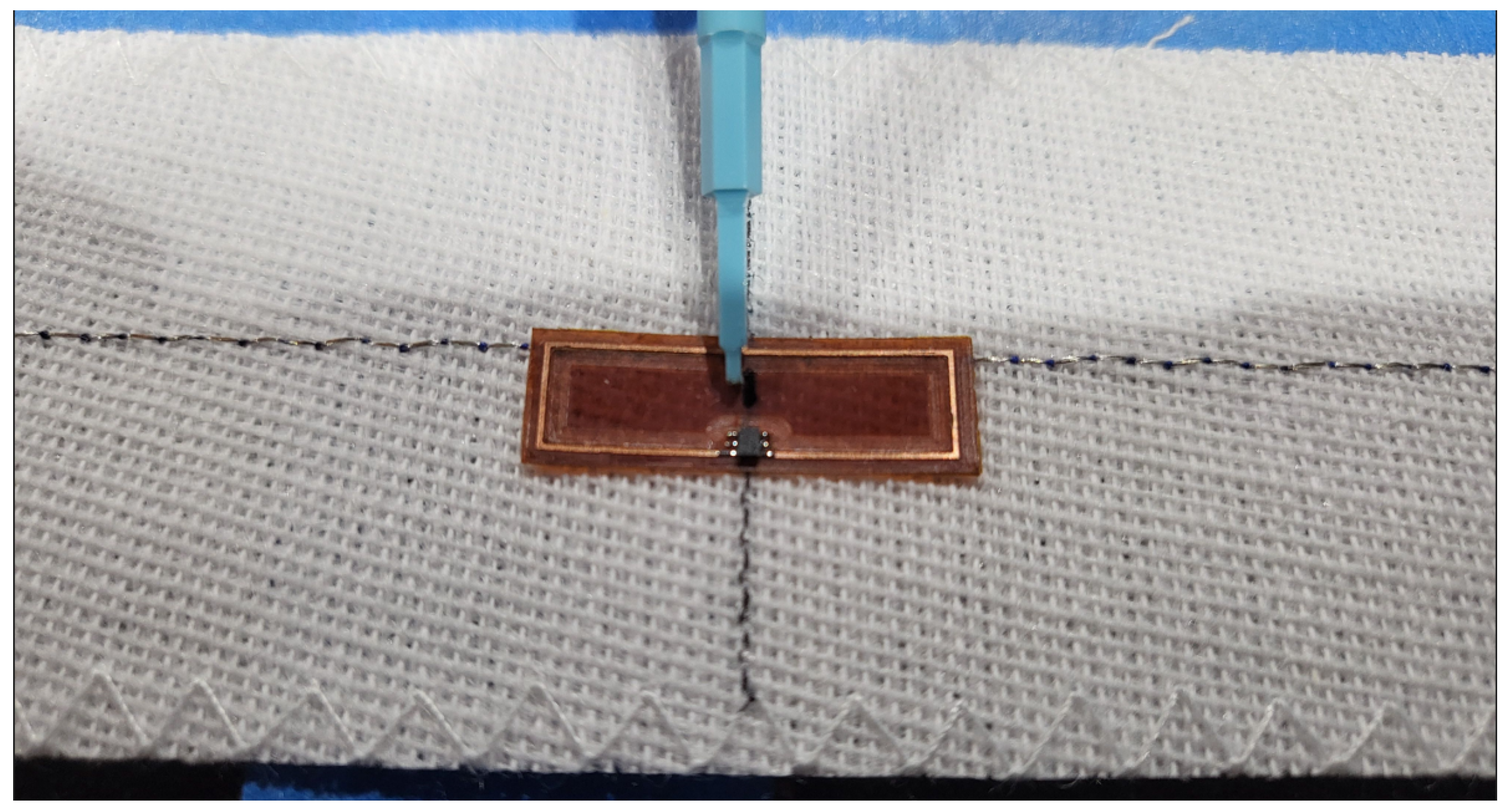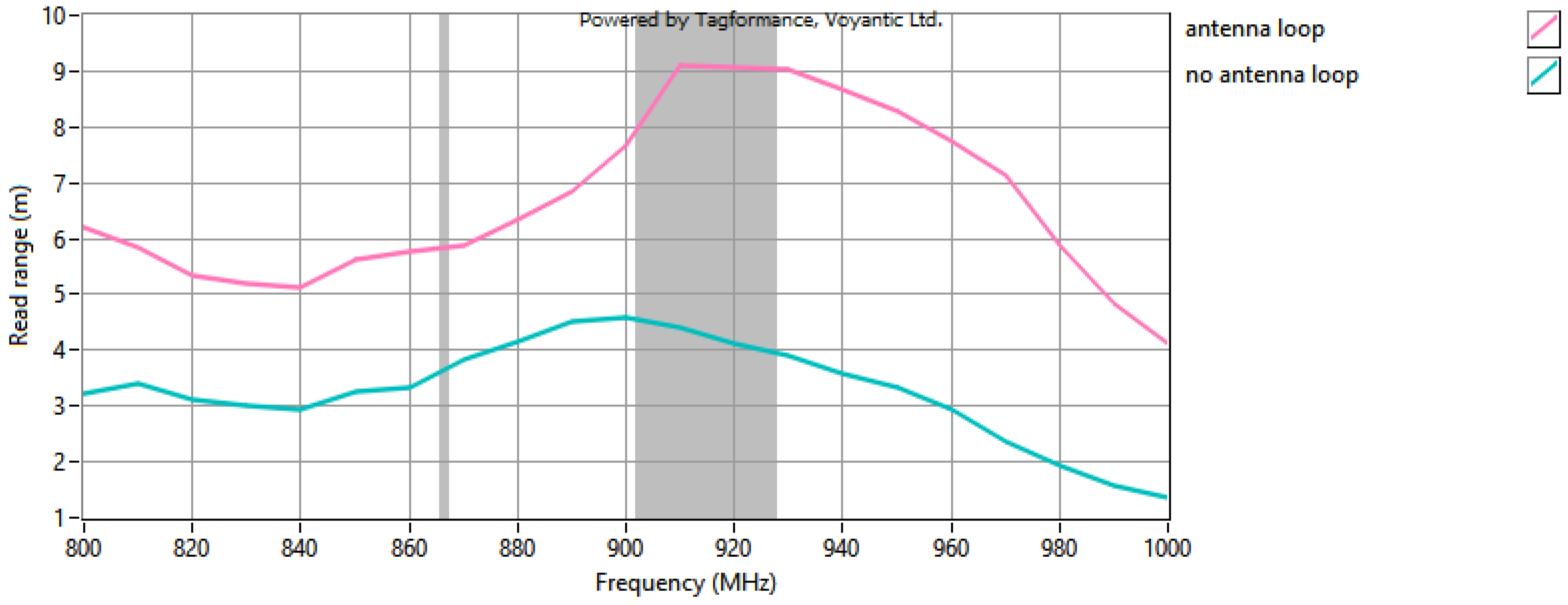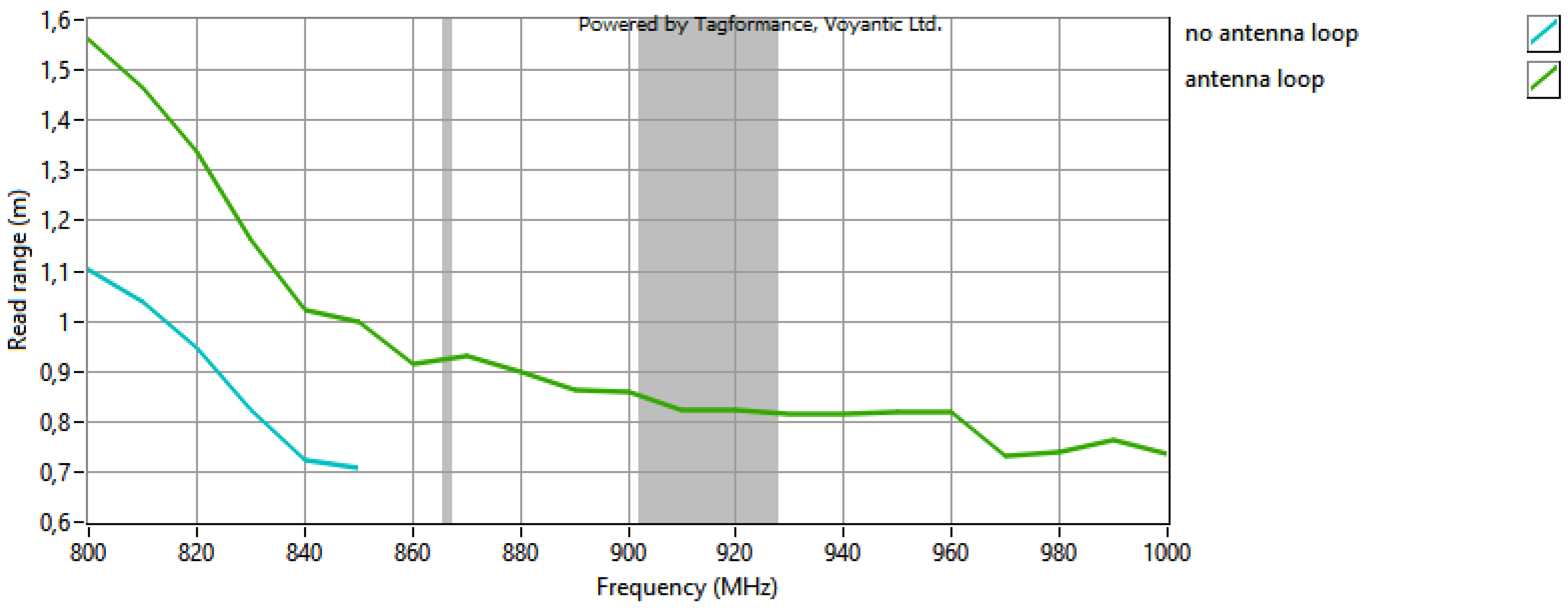3.1.1. Mathematical Model of Textronic UHF RFID Transponder
The foundational mathematical model of the transponder, which includes both the chip and antenna coupling systems, was extensively detailed in publication [
42]. In this paper, we focus only on the most crucial information from that model that underpins the ongoing research.
The electrical equivalent of the radiofrequency frontend in the textronic UHF RFID transponder is depicted in
Figure 7.
The left circuit refers to the antenna module, which physically consists of an embroidered antenna (half-wave dipole) and its coupling circuit. The right circuit represents the microelectronic module, containing the chip coupling circuit and the chip. Both circuits are magnetically coupled. It should be explicitly noted that the embroidered antenna module is not identical to the transponder antenna, which is highlighted on the diagram with a red border. The transponder antenna consists of an embroidered antenna connected through inductive coupling to the chip coupling circuit.
The physically constructed antenna module comprises the radiator and the coupling circuit. Its impedance can be described by the following formula:
where
represents the resistance, and
represents the reactance.
The right circuit is the microelectronic module, comprised of a chip and its coupling circuit. The impedance of the chip coupling circuit can be expressed as follows:
where
represents the resistance, and
represents the reactance.
The inductive coupling between the antenna and chip coupling circuits can be described using the mutual inductance coefficient
M. The impedance
contains only the imaginary part
:
where
represents the angular frequency.
The presented electrical circuit can be represented by a two-port network as it resembles the circuitry of an air-core transformer. Using the equivalent circuit, formulas for the impedance of the transponder antenna
, and the chip voltage
can be derived:
where
is the microelectronic module current,
is the antenna module voltage,
is the chip impedance.
The quality of the inductive coupling is crucial for the operation of the transponder because it determines the amount of energy transferred to the microelectronic circuit. The read range of the transponder depends on the power delivered to the chip. The power is determining by the chip voltage, which, according to Equation (5), reaches a maximum for a certain value of . Thus, the efficiency of the operation of various transponder coupling circuit designs can be estimated by comparing their mutual inductance coefficients. However, determining this value poses an issue, as numerical software lacks a direct function for calculating it.
3.1.3. Transponders with Planar Chips and Antenna Coupling Circuits
The primary function of the antenna coupling circuit is to facilitate energy transfer between the antenna and the microelectronic module. In addition to this, the antenna radiator itself generates a magnetic field, contributing to the overall field of the coupling circuit. Thus, the magnetic flux around the chip coupling system is the result of both the antenna coupling circuit and the radiator.
Previous research on textronic UHF RFID transponders commonly examined designs featuring a loop antenna coupling circuit paired with a two-loop chip coupling circuit. Incorporating an additional loop into the coupling circuit increases the mutual inductance, with the mutual inductance coefficient,
M, being the sum of the inductance coefficients from each loop of the antenna coupling circuit. The equation for this is
where
represents the total mutual inductance coefficient between the antenna module and the chip coupling circuit. Here,
is the mutual inductance coefficient between the first loop of the chip coupling circuit and the antenna, and
corresponds to the mutual inductance between the second loop and the antenna.
The numerical and experimental impacts of adding additional loops to the chip coupling circuit have been thoroughly investigated. Three chip coupling circuits were designed, each featuring an outer loop diameter d = 5.7 mm, a track width of 0.2 mm, and a loop-to-loop spacing of 0.2 mm (
Figure 8). For each simulation, an antenna coupling circuit was configured as a circle with a diameter of 5.7 mm (
Figure 9). The antenna’s radiator was designed with a length of 160 mm.
Section 2 describes the parameters of the transponders modeled in EMCoS Studio. Using Equations (5) and (6), along with the numerically calculated impedances of the transponder antenna
, embroidered antenna
, and chip coupling circuit
, the mutual inductance
and chip voltage
were calculated (
Figure 10). Each simulation assumes that an antenna module is
V and a chip impedance of
. The calculations span frequencies from 0.5 to 1.2 GHz. This broad frequency range was chosen to explore how variations in coupling circuits affect antenna resonance and the frequency shift of the maximum chip voltage
. The studies presented here are preliminary, conducted under the assumption that future methods will be developed to adjust antenna arm lengths to manipulate the position of the maximum
on the frequency axis. At this stage, the focus is not on the practical applicability of transponders in designated RFID bands but on understanding the underlying principles.
The results highlight significant differences in performance across the configurations. For the single-loop design, the maximum mutual inductance achieved was 3.19 , with a chip voltage of 0.014 V. Introducing a second loop markedly improved the inductive coupling between the circuits. However, adding a third loop only slightly increased and paradoxically reduced the voltage, indicating that it surpassed the optimal value for this transponder design. This addition also caused a noticeable shift in the maximum on the frequency axis and a narrowing of the operational frequency range.
In this setup, the loops are placed a few millimeters from the antenna arms, simplifying the embroidery process. Nonetheless, the greater distance from the radiator weakens the magnetic induction, leading to reduced inductive coupling. To address this issue, square-shaped antenna and chip coupling circuits were used, enhancing the coupling efficiency.
Figure 11 illustrates three different geometries of the embroidered antenna paired with a square coupling circuit.
The first geometry adapts the previously explored circular coupling circuit into a square shape, but with only three embroidered sides. The second design features a fully embroidered square, necessitating a change in the placement of the antenna arms to accommodate the new shape. Specifically, the arms are aligned with the center of the square, with one arm passing through the square’s area. The third design adopts a U-shaped antenna, where the bend itself functions as the coupling circuit.
To evaluate these designs, square coupling circuits with varying side lengths were tested: 5.7 mm, 11.2 mm, 15.8 mm, 20 mm, 30 mm, 40 mm, and 50 mm. These dimensions were chosen to reflect common sizes of decorative and functional elements in clothing, ranging from small sequins to large buckles. Each antenna arm extends 8 cm from the edge of its coupling circuit. The calculated values of mutual inductance
and chip voltage
for these configurations are illustrated in
Figure 12,
Figure 13 and
Figure 14.
The alteration in the shape of the coupling circuits significantly impacted the relationship between the mutual inductance and frequency. With circular circuits, mutual inductance consistently increased with frequency. In contrast, square circuits displayed extrema in both mutual inductance and chip voltage , with these extrema occurring at different frequencies for each chip coupling circuit. Notably, the first and third designs, which only differed in the angle between the antenna arms and the edges of the coupling circuit, exhibited similar distributions of extrema on the frequency axis. Across all designs, significantly higher chip voltages were achieved, suggesting that these transponders could potentially offer a greater read range compared to those using the traditional two-loop chip coupling circuit. Notably, the highest voltages were recorded in the designs featuring U-shaped antenna arms.
3.1.4. Transponders without Antenna Coupling Circuit
Since the radiator itself generates a magnetic field, this raises the question of whether this field alone is sufficient for the inductive coupling of the embroidered antenna with the chip. It is evident that transponders designed this way tend to have weaker inductive coupling compared to designs with a dedicated antenna coupling circuit. However, eliminating the coupling circuit reduces the consumption of conductive threads and lowers the antenna module resistance , which impacts the mutual inductance and chip voltage , according to Equations (5) and (6).
It is important to recognize that there is an optimal value of mutual inductance at which the chip voltage peaks. In cases where the large dimensions of the chip coupling circuit result in an excessively high , reducing the size of the circuit could decrease to more desirable levels. The selection of the chip coupling circuit’s size and geometry should be tailored to the specific garment element on which it will be placed. Additionally, fabricating the antenna without a coupling circuit is simpler, uses less conductive thread, and requires less space on the garment, enhancing the versatility of this transponder design for various clothing applications.
A simple dipole antenna can be easily embroidered, even by beginners in sewing, opening up the possibility for the widespread adoption of such textile transponders among electronics and IoT enthusiasts. They could integrate these transponders into their systems and wearable devices. Transponders could be marketed as kits, consisting of a pre-assembled microelectronic module and conductive thread. Users’ tasks would be to embroider the dipole antenna and attach the microelectronic module as per the included instructions.
It should also be noted that placing the antenna directly in the middle of the chip coupling circuit results in the weakest coupling due to the opposing directions of the magnetic induction vectors on either side of the conductor. Positioning it outside the chip’s area leads to the strongest coupling.
A simulation was conducted using a dipole antenna with a length of 16 cm, with the microelectronic circuit positioned at the antenna’s midpoint. The antenna was placed as close to the edge of the chip coupling circuit as possible while remaining outside its area, as depicted in
Figure 15. Initially, square-shaped chip coupling circuits with side lengths of 5.7 mm, 11.4 mm, 16 mm, 20 mm, 30 mm, 40 mm, and 50 mm were examined. The values of the mutual inductance
and chip voltage
were calculated for each model (
Figure 16). These results can be compared to those shown in
Figure 12, where the primary difference is the absence of the antenna coupling circuit in the current models. As anticipated, the voltage values obtained in this configuration were lower. Notably, two frequency ranges were observed in this setup, each corresponding to a maximum voltage for the circuit. The highest voltage in this setup was achieved with the 11.4 mm, square, while larger squares performed better in the previous configuration with an antenna coupling circuit.
The magnetic flux density decreases with increasing distance from the conductor. To maximize it, it is advantageous to position the largest possible surface area of the coupling device as close to the antenna as possible. Consequently, rectangular coupling circuits were designed (
Figure 17). Each chip coupling circuit was shaped as a rectangle with a shorter side measuring 5.7 mm, while the length of the longer side varied among 11.4 mm, 16 mm, 20 mm, 30 mm, 40 mm, and 50 mm.
Initial calculations were conducted for configurations where the coupling circuit’s longer side was adjacent to the antenna (
Figure 18). By shortening one side and extending the other side closest to the conductor, an increase in chip voltage was observed across almost all modules. Furthermore, the frequency at which the maximum chip voltage was reached remained consistent across most configurations.
For clothing designers, rotating the rectangular microelectronic layout so that its shorter edge is parallel to the antenna may seem beneficial (
Figure 19). However, this configuration results in a reduction in the magnetic flux enclosed by the circuit, as the surface area close to the conductor generating magnetic induction is shifted to a region farther from the antenna. This effect is evident in the observed decreases in the mutual inductance
and
, as illustrated in
Figure 20. As expected, these voltages are lower compared to those obtained from transponders with a square antenna coupling circuit.
Nevertheless, transponders without a square coupling circuit demonstrated greater stability in positioning the maximum chip voltage on the frequency axis. This indicates a significant influence of the antenna coupling circuit’s length on this parameter, highlighting a critical design consideration for optimizing transponder performance.
3.1.5. Transponders with Antenna Coupling Circuit Wrapping around Chip Coupling Circuit
Wrapping the conductive thread around the chip’s coupling circuit can create a transponder design that minimizes the likelihood of the coupling systems separating and, consequently, deteriorating the read range. However, the geometry of the weave must be carefully designed in accordance with the laws of electromagnetism to ensure adequate inductive coupling between the circuits.
When sewing the microelectronic circuit, the formation of knots occurs where the conductive thread crosses the path of the chip coupling circuit perpendicularly. According to Equation (8), if the thread at the knot wraps around the coupling system’s path at a right angle, the magnetic flux at that point will be zero. However, if the knots are sufficiently spaced, the thread segments between them will run parallel to the microelectronic circuit’s path. These straight segments are crucial as they generate the magnetic field that enables inductive coupling between the antenna and the chip.
For effective inductive coupling, it is essential to sew the conductive thread in a manner that, despite the necessary knots, emulates the shape of a planar antenna coupling circuit. While ignoring the knots, the magnetic flux density is described by Equations (12) and (13). Nevertheless, the presence of knots and the curvature of the thread between them significantly impacts these parameters, influencing the overall effectiveness of the coupling.
Designers may opt to sew the coupling circuit with only one or a few closely placed knots for aesthetic reasons, as discussed in the section on transponders without an antenna coupling circuit. In such cases, it is crucial to carefully position the microelectronic circuit relative to the radiator. Reference [
46] presented designs where the conductive thread wrapped around the chip coupling circuit effectively serves as the antenna coupling circuit and generates a magnetic field strong enough to compete with the radiator.
Additionally, there are several technical limitations to consider. The use of insulated conductive thread is necessary to prevent short circuits, and unlike previous planar designs, it is not feasible to substitute this thread with conductive inks. The microelectronic module’s manufacture is also more complex, requiring an opening in the middle of the chip circuits, and the chip housing must be designed so as not to obstruct the thread placement.
This construction method is also suitable for clothing elements that extend beyond the fabric, where the conductive thread encircles the chip coupling circuit without passing through the material. In such designs, special attention must be given to ensure that the thread does not slip and that the geometry of the coupling circuit remains intact.
As discussed in this section, simulations were performed on transponders featuring square-shaped chip coupling circuits with a side length of 11.4 mm. This particular module size was selected based on the high chip voltage achieved in previous designs, suggesting its efficacy. One of the goals of this construction was to address the issue of separation between the antenna and chip coupling circuits. To ensure a robust connection, careful consideration was given to the number and placement of knots. It was determined that securing the chip circuit at its corners, or, additionally, at the midpoints of its sides, would be sufficient.
It is important to clarify that the primary purpose of sewing the microelectronic circuit with conductive thread is not just to attach it to the material, but more crucially, to prevent the coupling circuits from moving relative to each other. For additional security, regular threads can be used for further fastening.
Initially, modules with knots placed at the corners and midpoints of the sides were tested to assess how the number of knots affects inductive coupling. Four wrapping methods proposed to optimize this effect are illustrated in
Figure 21. In the first method, shown in
Figure 21a, the knot starts on one side of the chip coupling circuit’s path and ends on the other, positioning the thread diagonally across the path. Another approach, depicted in
Figure 21b, explores changing the winding direction of the thread.
For segments between knots, a parallel alignment with the circuit’s path was tested. The knots can be initiated and concluded on the same side of the path, which can be either inside or outside the chip coupling circuit’s area. The choice of side determines whether the area of the antenna coupling circuit is larger or smaller than that of the chip circuit, influencing the potential for inductive coupling. It is anticipated that configurations with parallel segments and a larger circuit area will exhibit higher values of mutual inductance . However, variations in the amount of conductive thread used for each design also impact the resistance as indicated by Equations (5) and (6), affecting the resultant and chip voltage .
For each of the four wrapping methods, a transponder model was constructed to match the design featuring a planar square-shaped coupling circuit, as shown in
Figure 11a. The model with the wound antenna coupling circuit is depicted in
Figure 22. The length of the conducting thread used to construct the antenna and its coupling circuit varied depending on the wrapping method, measuring 203.97 mm for methods 1 and 2, 215.079 mm for method 3, and 207.08 mm for method 4. The antenna arms for each model were consistently 160 mm in length. The results of mutual inductance
and chip voltage
from these models are presented in
Figure 23.
The same four winding methods previously described were applied to wind the coupling circuit with conducting thread, but only at the corners, as illustrated in
Figure 24. Additionally, for the method involving sewing with knots at the corners, six different antenna geometries were examined (
Figure 25). This approach was intended to mirror the pattern of constructions with a planar antenna coupling circuit. Consequently, transponders with identical arm arrangements, similar to those depicted in
Figure 11a–c, were tested.
Three additional geometries were also proposed to accommodate specific design needs. In these configurations, the coupling circuit is positioned not in the middle, but at the end of the antenna, or only two sides of the chip coupling circuit are wound. These designs are particularly suitable for transponders that are integrated into clothing elements which protrude beyond the material, allowing for greater design flexibility and application-specific customization.
The results from the first construction, depicted in
Figure 26, allow for a comparison of the effects of using different numbers of nodes in the winding. This particular coupling circuit required less conducting thread, with lengths measuring 200.10 mm for the first two cases, 206.52 mm for the third, and 199.68 mm for the fourth. Notably, the second and third weaving patterns, between 0.6 and 0.7 GHz achieved higher mutual inductance
values compared to configurations with a greater number of nodes. This observation correlates with a significant decrease in voltage for these models, suggesting that lower
values are closer to being optimal for strong coupling in this context.
Interestingly, the weave with the weakest coupling exhibited the highest chip voltage . This phenomenon indicates that a greater number of nodes, which typically weaken the magnetic field, can lead to higher voltages. In scenarios where the magnetic field is overly strong, it can be moderated by adding more nodes. Conversely, reducing the number of nodes can strengthen a weak magnetic field. The variations in and due to different node counts also stem from changes in antenna resistance, which, according to Equations (5) and (6), affect these values both directly and indirectly through alterations in . Additionally, designs that require a larger number of nodes—and consequently more conducting thread—tend to have higher resistance.
Given the minimal differences in the and values between models with different winding directions of the thread, subsequent simulations focused solely on the right-hand winding case.
The results from the subsequent two constructions, as depicted in
Figure 27 and
Figure 28, reveal a clear dependency on the type of wrapping used. In the frequency range of 0.6 to 0.7 GHz, where the maximum chip voltage
occurs, the
graph indicates an optimal value that lies between those for the individual windings. Notably, neither the braid with the strongest nor the weakest coupling produced the highest
. Instead, the highest voltage was achieved by the model featuring the diagonal pattern. Conversely, for constructions with a U-shaped antenna, the weakest coupling corresponded to the highest chip voltage.
In this scenario, reducing the size of the coupling circuit could decrease the magnetic flux, making the transponder more suitable for smaller clothing items. Additionally, having the antenna arms directed in one direction also conserves space, facilitating the application of the transponder. Although the differences in chip voltage among the wrapping methods are smaller compared to the design where the antenna passes through the center of the coupling circuit, a noticeable shift in their maximum values along the frequency axis is observed.
Compared to designs where arms are perpendicular to the coupling circuit, significantly higher chip voltages were recorded in these models. The examination of the corresponding values, which were notably lower, suggests that designs with perpendicular arms may exhibit excessive coupling. This observation implies the need for a coupling circuit with a reduced surface area. Moreover, when compared to models with planar coupling circuits, this model with a coupling circuit chip of equivalent size achieves higher or lower chip voltages, depending on the effectiveness of the selected wrapping method.
In
Figure 29,
Figure 30 and
Figure 31, results are presented for constructions designed specifically for clothing elements where the conductive thread wraps around without passing through the fabric. The shapes of the plots in
Figure 29 resemble those seen in
Figure 26, with the main difference being the removal of one side of the antenna coupling circuit. This modification led to a higher level of inductive coupling, which, interestingly, resulted in a reduction in the chip voltage
. This outcome likely stems from the specific arrangement of the antenna arms.
The two subsequent designs, shown in
Figure 30 and
Figure 31, differ only in the placement of the coupling circuit relative to the radiator. The plots from these configurations were similar, yet for the coupling circuit positioned at the midpoint of the radiator, higher voltages were recorded. This increase can be explained by how the surface of the circuit covers the magnetic flux density vectors, which vary in direction relative to the radiator’s orientation. As a result, this strategic positioning helps mitigate the excessive coupling that typically leads to low
values in these designs.
In most of the designs examined, the highest chip voltage values were achieved with the diagonal pattern, which provided the lowest mutual inductance values. This result is due to the surface area of the square-shaped chip coupling circuit, measuring 11.4 mm per side, which generated a substantial magnetic flux, often exceeding the optimal threshold. Consequently, such transponders are advantageous when a small-sized coupling circuit is needed. Additionally, considering the other two weave patterns becomes important when aiming to increase the value, should it fall below the optimal range. The positioning of the antenna arms plays a critical role in influencing the resultant values of and .
Interestingly, unlike previous transponder groups, each weave pattern in this set peaked at the same frequency, except for the U-shaped antenna. Generally, for various arm arrangements, the peak values occurred within the 0.6 to 0.7 GHz range, though they varied in shape and potentially extended beyond this frequency span. This finding highlights the significant impact of weave geometry and the length of the antenna coupling circuit on the performance of the transponders, despite the consistent dimensions of the chip coupling circuit.
3.1.6. Transponders with Chip and Antenna Coupling Circuits Positioned on the Core
In this transponder design, the conductive wire is wound around a core to form coils, creating an antenna coupling circuit in a solenoid configuration. Employing multiple turns can significantly enhance the magnetic flux, even in smaller coupling systems. For the simulation, a single-loop coupling circuit with a diameter of 5.7 mm was used, resulting in lower mutual inductance
and chip voltage
values, as illustrated in
Figure 10. The coils themselves had a diameter of 4.9 mm, which is slightly smaller than that of the chip coupling system, allowing the chip to be placed directly atop the coils. The spacing between the coil turns was set at 1.33 mm.
The core of the coils measured 4.5 mm in diameter and 8 mm in length (
Figure 32). It was made from ’Glass, Bead’, a material chosen from the EMCoS Studio library that resembles the type of glass commonly used in ornaments and jewelry. This choice not only enhances the transponder’s decorative appeal, but also aligns with the dimensions of typical decorative beads, making the design aesthetically pleasing for applications where appearance is crucial. Additionally, functional elements such as cylindrical buttons, frequently found on garments like trousers or denim jackets, could serve as practical alternatives for the core material, further integrating the transponder seamlessly into fashion items.
Three transponder models were developed, each incorporating a different number of turns in the antenna coupling circuit: two, four, and six turns, respectively, as shown in (
Figure 33). The impact of the number of turns on the mutual inductance
and chip voltage
is detailed in
Figure 34. Among these, the model with four turns demonstrated a notable enhancement in inductive coupling compared to those with a planar coupling circuit. Although its maximum
was close to the configurations with two and three loops, it did not surpass them.
In refining this model, the initial step involved winding conducting thread onto the core, followed by positioning the microelectronic module onto the coils. Considering that the magnetic field is confined within the solenoid, it is crucial to calculate the magnetic flux across the chip coupling circuit’s cross-section to ensure that it is fully enveloped by the magnetic field. To achieve this, a new model was devised where coils were wound around both the core and the microelectronic module. All model parameters were kept constant, except for the coil diameter, which was increased to 6.3 mm to cover more surface area. This adjustment resulted in a slight increase in voltage across all numbers of turns (
Figure 35). Moreover, there was a noticeable shift in the frequency maximum, likely due to the larger coil diameter and the resulting increase in the length of the entire antenna module.
In both initial models, the configuration with six turns underperformed, which was likely due to the excessive distance between each turn. To remedy this, the spacing between the turns was decreased to 0.8 mm in a subsequent iteration of the model. This change was implemented in the transponder design where the microelectronic module is mounted directly on the antenna system. As shown in
Figure 36, this adjustment met expectations: the revised model with six turns now achieved the highest chip voltage
.
Furthermore, reducing the distance between the turns not only improved the performance of the model with six turns but also had a positive impact on the four-turn model, resulting in an increased chip voltage. Conversely, this modification led to a decrease in voltage for the model with two turns. This outcome suggests that the optimal spacing between turns can vary significantly depending on the total number of turns in the antenna coupling circuit.
In the final phase of this research, a pivotal modification was made to the initially simulated model by changing the core material. Instead of the material commonly found in the clothing industry, ferrite, a popular core material in electronics, was selected. The specific type of ferrite chosen from the EMCoS Studio library is labeled “N30”. As depicted in
Figure 37, the resulting chip voltage
was lower than that obtained with the glass core. It exhibited a noteworthy characteristic: the slopes of the voltage maxima decreased more gradually, thereby covering larger frequency ranges. This alteration in core material also notably enhanced the performance of the model with six turns, which had previously shown suboptimal results.

